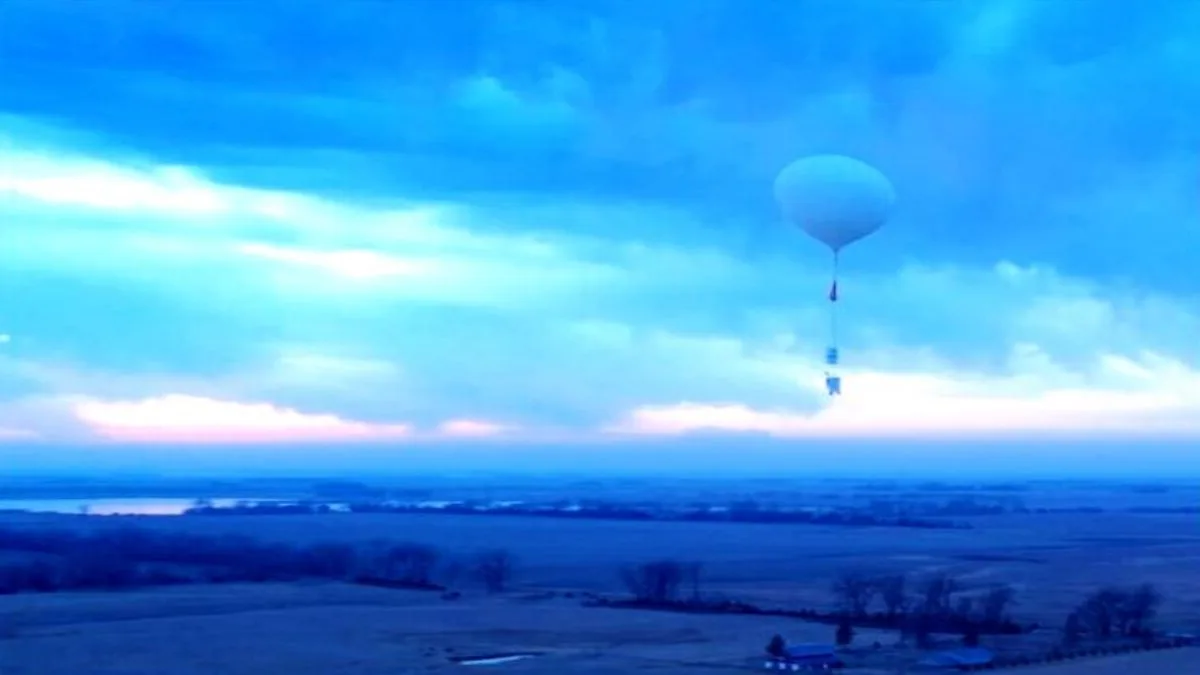The UK’s Defence Equipment and Support (DE&S) agency has completed a significant milestone in its effort to use high-altitude balloon technology for defence operations. In a series of test flights conducted over South Dakota under Project Aether, British-developed unmanned balloons demonstrated their ability to deliver continuous ISR (intelligence, surveillance, reconnaissance) and secure communications at altitudes of 60,000 and 80,000 feet.
Operating as an integrated constellation for the first time, the balloons maintained near-continuous coverage over a large footprint. Each platform was able to fly for five days, covering more than 2,000 nautical miles per mission. The test series spanned almost a month in total flight time, with a single operator managing the balloon launch and navigation, even in challenging weather conditions.
“These latest tests have been extremely fruitful and pave the way for us to work more collaboratively with our allies to develop capabilities that benefit our armed forces,” said James Gavin, head of the Defense Innovation – Prove and Exploit team at DE&S.
Strategic Drivers and Recent Global Examples
The push for cost-effective alternatives to satellites and manned ISR aircraft comes at a time of growing concern about the use of high-altitude platforms by adversaries. In recent years, Chinese surveillance balloon overflights over U.S. territory have created diplomatic tensions and exposed gaps in early warning systems. The incident of a Chinese high-altitude balloon drifting over sensitive U.S. airspace in 2023 catalyzed NATO discussions about air sovereignty and spurred new investment in balloon detection, tracking, and deterrence technology.
In contrast, the UK’s Project Aether seeks to reclaim the high ground by using transparent, modular and versatile capabilities. With payloads of up to 3 kilograms, including ISR sensors and communications relays, these balloons are designed for rapid deployment, low operating cost and minimum logistical footprint – providing a highly scalable toolset for both military and humanitarian use.
Defense Acquisition Secretary Maria Eagle said, “This type of stratospheric technology could change how we operate in complex environments, “keeping our people safer and better informed than ever before.”

- On February 3, 2023, a U.S. Air Force pilot spotted a suspected Chinese surveillance balloon circling over the central United States. Recovery operations began immediately after it was shot down. (U.S. Department of Defense)
Dual-use programs and benefits
Project Aether envisioned as a modular platform has been developed that can support both defense and civilian missions. In addition to battlefield surveillance and military communications, balloons can also provide weather monitoring, disaster response**, *broadband connectivity* in remote regions**, and *emergency weather forecasting* in environments inaccessible to traditional infrastructure.
Key benefits of the system include:
- Cost efficiency: Continuous monitoring and communications at a fraction of the cost of a satellite or aircraft.
- Rapid deployment: Easily launched with minimal support staff or infrastructure.
- Operational flexibility: Ideal for both static monitoring and wide-area coverage with minimal overhead.
- Precision navigation: Despite atmospheric variability, the test balloons demonstrated accurate station-keeping.
Limitations and development considerations
Despite promising results, the current system is not without limitations. The current payload capacity is relatively remains low, which is difficult to achieve with onboard sensors or jammers. Or limits the complexity of active systems such as precision targeting modules. Operational duration, although reaching several days, falls short of ideal long-duration missions and technological advances 6 to 12 months will be required to reach endurance targets. MoD.
There are also atmospheric constraints: winds and stratospheric storms can affect station-keeping, particularly in volatile regions or near disputed borders. However, DE&S believes that continued improvements in envelope materials, onboard AI navigation and predictive weather modelling will reduce these challenges in the next development phase.
Read More: China Expands South China Sea Network With 27 Military Bases, Some Capable of Hosting Nuclear Bombers
Future Paths
The successful trials feed directly into the UK’s broader Transformation Plan doctrine, which emphasises innovation, affordability and adaptability in defence procurement. Partner companies Voltitude, Landguard Systems, and US-based Aerostar played key roles in balloon production and flight management – signaling a deepening of cross-Atlantic collaboration in dual-use aerospace technology.
The UK is actively exploring Heavy Payload Variants and Semi-Autonomous Constant Control, with defence analysts suggesting that Project Aether could develop into a cornerstone ISR tool in NATO’s broader theatre-awareness architecture.
As strategic competition for the upper atmosphere intensifies – and Chinese overflights are still fresh in the memory – Britain’s investment in a transparent, secure and sovereign balloon-based platform provides a timely counterweight to emerging grey-zone tactics.
FAQs
Project Aether is a UK Ministry of Defence initiative exploring the use of unmanned, high-altitude balloons for ISR and communications. In tests conducted over South Dakota, the balloons operated at altitudes of 60,000 to 80,000 feet, providing near-continuous coverage for about a month. This approach offers a cost-effective alternative to traditional satellites and manned aircraft.
Unlike satellites, which are expensive and complex to deploy, and manned aircraft, which require significant resources, these balloons offer a low-cost, rapid-deployment solution. They can remain airborne for long periods without maintenance, providing continuous coverage with minimal logistical support.
In addition to military uses, these high-altitude balloons could support disaster response by delivering fast internet connectivity to remote areas. They could also help with climate research and weather forecasting by providing data from the stratosphere.
Current limitations include a modest payload capacity of up to 3 kilograms and an operation duration of no more than five days. Future developments aim to increase payload capacity and extend mission durations to 6-12 months. Atmospheric conditions such as wind and storms can also affect the stability of the balloons, but advances in materials and AI navigation are expected to reduce these issues.
Continue Reading: Space Force to Launch Eighth X‑37B Spaceplane Flight Next Month








Leave a Reply